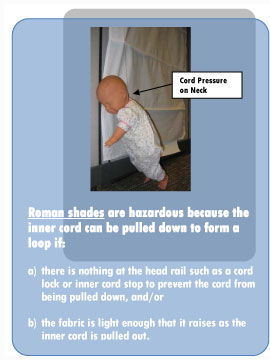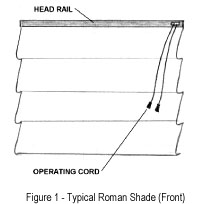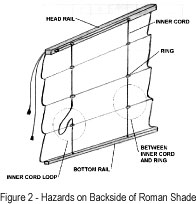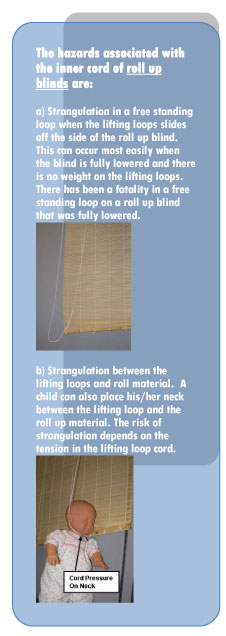For more than a decade the U.S. Consumer Product Safety Commission (CPSC) has been focused on reducing injuries and deaths associated with window coverings. The CPSC first addressed the issue after receiving reports of incidents involving cords on window blinds.
The inner cords of Roman shades (see Fig. 1 and 2) are particularly accessible because the cords run through rings or slots in the back of the shade that are spaced fairly wide apart (typically 8 inches) as shown in Fig. 2. This large spacing creates the potential for a child to place his/her neck in the length of cord between the rings. Furthermore, some Roman shades do not use a head rail with a locking mechanism to limit the movement of the operating cords, increasing the ease with which a loop can be formed by pulling down on the inner cord.




A roll up blind is a window covering product that consists of some type of flexible material that is rolled up and suspended by two cord loops, called lifting loops as seen in Figure 3. When the lifting loop cords are pulled, the loops rise, causing the flexible material to roll up from the bottom of the blind. The cords that loop around the rolled material are referred to as the inner cords. The same cords on the other side of the head rail that are pulled to raise the rolled up material are called operating cords.
CPSC reminds consumers to examine all Roman shades and roll up blinds in their homes.
If looped pull cords are present or exposed inner cords are found on the back of blinds or shades and children are in the home or occasionally visit your home, please consider replacing them with blinds or shades that do not have exposed pull cords or inner cords.
The above information and illustrations are from the Consumer Product Safety Commission (www.cpsc.gov) Publication #5115.
Click here to read about the strangulation hazards associated with mini-blinds. |